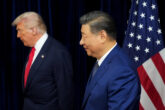July 31, 2018
Behind The Magical Thinking
Lessons from Policymaker Relationships with Drones
Executive Summary
Drones’ greatest attraction for the national security world is that they create options where there were none – or none at a cost policymakers feel comfortable with. With a public tired of large scale military interventions, drones and other approaches that gave the U.S. options to study or intervene against security challenges in a low profile, low risk way fit perfectly into the Obama administration’s comfort zone. These platforms came to symbolize and enable much of the Obama national security team’s approach.
But the enthusiastic embrace of drone technology, particularly in counterterrorism, left some former Obama officials questioning whether they’d been clutching a Pandora’s box they should have opened more deliberately. Overall, such “light footprint” strategies generate enduring disagreements about their efficacy, risk, and oversight. Unlike any other recent military platform, drones in particular engender strong emotion - hope, revulsion, overconfidence, demonization - and magical thinking, even among those who know them best. And the attributes that make them so compelling – that they are precise, remote, sensing, and unmanned – may sometimes be too reassuring.
The Trump administration inherited these dynamics, along with the nascent Obama drone policies and array of security challenges – but little of the prior administration’s familiarity and comfort with any of them. Whatever history’s take on the Obama administration’s approach to asymmetric threats, its officials’ uniquely close relationship with drones as a platform and immersion in the relevant strategy is unquestioned. Where their policy was flawed, they often believed these flaws were mitigated by their own painstaking attention and oversight.
Trump’s team is forging its own path, increasing employment of drones and overall counterterrorism activity while keeping their new policy quiet. But flat rejection of Obama-era approaches is risky. How senior policymakers perceive drones matters a lot in setting our own norms, and policymakers’ relationship with these capabilities is itself an entry point for understanding how light footprint approaches are applied. Exploring this foundation – policymakers’ blind spots, lessons learned, and good and bad habits – is critical for current and future policymakers.
This paper is the second in a CNAS series dedicated to understanding how 16 years of extensive drone use have affected the dynamics of national security decision- making, based on interviews with former senior officials primarily from the Obama administration.
Key Insights
As a rule, policymakers initially underestimate drones’ cost and profile and overestimate their availability, capabilities, range, and “tail” requirements, though some Obama-era officials grew more sophisticated in their understanding of drones over time. U.S. counterterrorism and crisis response approaches have been built on these same assumptions around so-called light footprint warfare’s precise impact, as well as low cost, risk, and resource demands. Misunderstanding or downplaying the toll of such approaches will affect policymaker calculations.
Drones allow U.S. policymakers to monitor a situation that might otherwise be entirely off limits - but this access has generated insatiable demand and, with it, risks. Policymakers may place greater faith in the value of real-time information than is warranted. They may be drawn into tactical decisions or intervention in scenarios that might not merit U.S. engagement. And they can underestimate the impact of real-time demands on force structure and human capital, with expectations of certainty that are impossible or unaffordable.
Demand rather than effectiveness and appropriateness often set the pace for drone allocation under the Obama administration, and the efficacy of strategies associated with drones is inconclusive. Policymakers’ biggest frustrations with drones were lack of supply and, with it, how best to allocate drones against a range of security challenges. As a result, they uniquely intervened in how and where drones were used.
Lowering the barriers for use of force is both a feature and a bug for drones. Some policymakers argued drones are simply part of a continuum of military techno-evolutions to “project power without projecting vulnerability”-itself responsive to public demands. But drones are unique in their ability to pair persistent ISR and kinetic capabilities into one package without risk to U.S. forces. This package of traits and the comparative secrecy of many drone activities also result in lower public and congressional scrutiny, and limits the feedback loop to policymakers. In the absence of measures of effectiveness, overapplication is possible. Obama officials were concerned enough about the risk that drones would lower the threshold for kinetic action to require dedicated senior policymaker oversight. But reliance on personal oversight has limits: people leave. Moreover, sequential administrations have made it increasingly easy to pursue use of force with limited congressional check. And legal and policy barriers often privilege “easy” kinetic actions at the expense of “harder” non-kinetic ones.
Officials in this study believed drone strikes are precise, but still worried about the potential for civilian casualties - and as the U.S. footprint have evolved, so have the approaches U.S. forces can use prevent and measure civilian harm. Most policymakers believed they’d made serious efforts to prevent civilian casualties to the greatest extent possible and to learn from mistakes.Policymaker concerns were due less to imprecision of strikes and more due to foundational analysis and process. Specifically: how closely civilian policymakers are involved in the definition of targets and review of intelligence; how constrained policymakers have been over time from discussing drone strikes publicly; and how disconnected policymakers are from the aftermath of such strikes. Outside analysts are worried that the government is making bad assumptions about the viability of preventing and measuring civilian casualties with theaters with limited U.S. assets – overhead surveillance and variable partner forces are simply no match for U.S. ground forces for ground truth.
Drones both enabled micromanagement and were themselves ripe for micromanaging - a practice that emphasized the tactical over the strategic. But this intensive oversight had thoughtful rationales. Many officials viewed micromanagement of drones as a necessary evil for establishing norms, and some described their micromanagement as an alternative to external transparency and oversight. But this oversight took enormous amounts of time, allowing less bandwidth for more strategic debate and putting emphasis on direct action against high value targets. The Trump administration is moving away from micromanagement of military operations, allowing lower level commanders to take decisions once made in the Situation Room. While this may be an attractive option, pursuing it would need to make up for the Obama-era rationales for micromanagement (norm setting, oversight) as well as the gaps generated by micromanagement (lack of attention to strategy and non-military tools).
Transparency is necessary to the strategy. By the end of the Obama administration, key steps had been taken to publicly acknowledge the legal and policy framework that governed the lethal drone program, to describe the decision process used to apply the program, to publicly announce basic information about some strikes, and to recognize (by the government’s accounting) civilian casualties. Still, many officials argued that further transparency necessary. The Trump administration seems to be moving counterproductively backward in drone transparency measures and military operations more broadly.
Enhanced secrecy impedes the public’s ability to oversee basic decisions about the scope of military actions taken in their name.
Summary of Policy Recommendations
The optimism associated with applying drones and other light footprint tools is well intentioned: meet national security objectives while generating low risk to our own forces and limited harm on the societies we are working with and among. But with that should come a realistic understanding of what effects we are generating, what we are actually capable of achieving, and whether these truly are the best means of accomplishing our goals. Toward that end, the Trump administration should:
- Educate themselves on the “tooth to tail” of light footprint capabilities – drones, special operation forces, etc. – including their growth in size and scope, the employment requirements and possible tradeoffs, and any readiness challenges, in order to more proactively manage this portfolio.
- Establish public and realistic security strategies, including goals and objectives around use of force and associated security activities.
- Generate measures of effectiveness to better understand where and how light footprint capabilities such as drones are most effective and deliberate processes (e.g., table top exercises) to assess alternative strategies and required complementary non-military tools.
- Examine and rationalize intelligence consumption, including how demand impacts the scoping of the intelligence community and requirements for real- time information.
- Invest in reviewing assumptions around counterterrorism targeting, including how artificial intelligence will be integrated into this process.
- Divest from micromanagement of drone operations by making up for its rationales (absence of public oversight) as well as the gaps generated by micromanagement (lack of attention to strategy and non-military tools).
- Invest in necessary predicates to delegation of security decisions: mutually understood strategies, trust and accountability between civilian and military leaders, left-and-right limits to policy, empowerment of lower level military and non-military national security officials, and mechanisms to raise serious concerns to senior officials.
- Reverse position discouraging updates to and constraints on Authorization for Use of Military Force.
- Launch review of non-kinetic counterterrorism tools, including legal, policy, and process barriers that unintentionally discriminate against non-kinetic approaches vs. kinetic approaches.
- Study how shifts from heavy to light footprint approaches have impacted U.S. ability to prevent and measure civilian casualties.
- Start internal and external oversight and review processes on civilian harm, how government and non-government organizations can work together in measuring it, and its impact on national security interests.
- Publicly announce current drone employment policy and reverse decisions to limit publicly available data on drone strikes and civilian casualties.
Also in the Series:
The full report is available online.
More from CNAS
-
Transatlantic Security / Technology & National Security
Look Before We Leap on Artificial IntelligenceThis article was originally published on The Dispatch. A debate about the role that artificial intelligence should and will play in society, and how it will affect humanity fo...
By Jon B. Wolfsthal
-
Technology & National Security
Caleb Withers on the Cybersecurity Frontier in the Age of AICaleb Withers, research associate at the Center for a New American Security, joins Kevin Frazier, the AI Innovation and Law Fellow at the University of Texas School of Law and...
By Caleb Withers
-
Technology & National Security
Prepared, Not ParalyzedExecutive Summary The Trump administration has embraced a pro-innovation approach to artificial intelligence (AI) policy. Its AI Action Plan, released July 2025, underscores t...
By Janet Egan, Spencer Michaels & Caleb Withers
-
Indo-Pacific Security / Technology & National Security
Sharper: Tech + ChinaRecent talks between President Donald Trump and Chinese Communist Party General Secretary Xi Jinping placed a spotlight on emerging technologies, from high-end chips to minera...
By Charles Horn & Sevi Silvia





